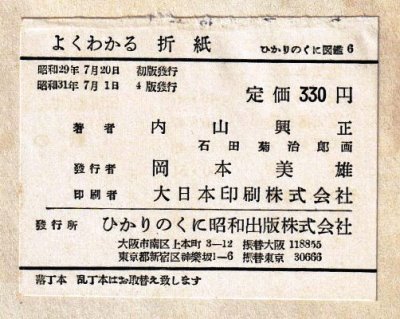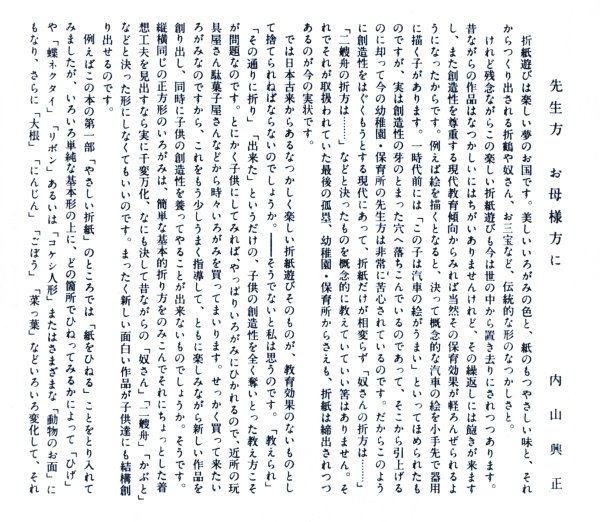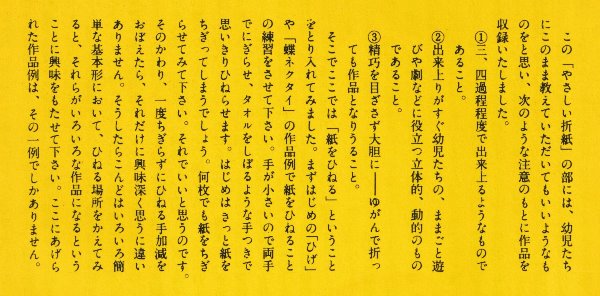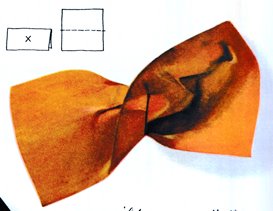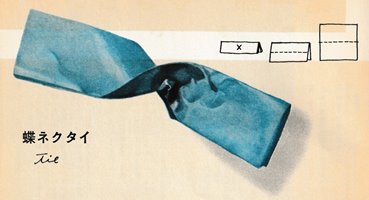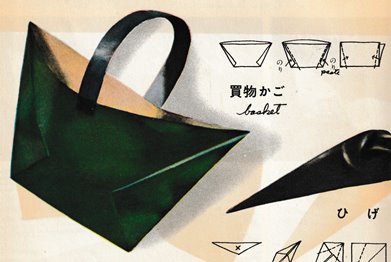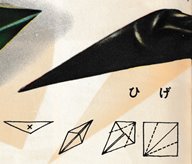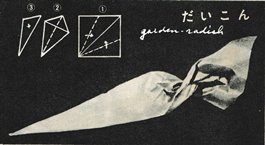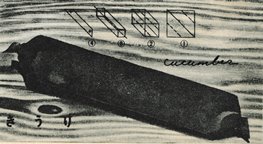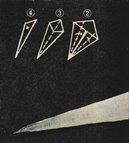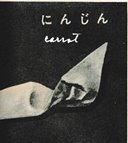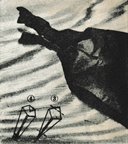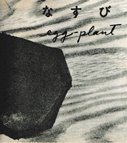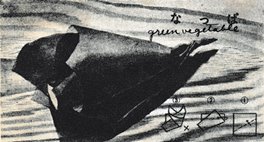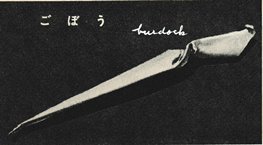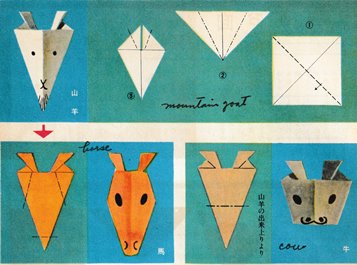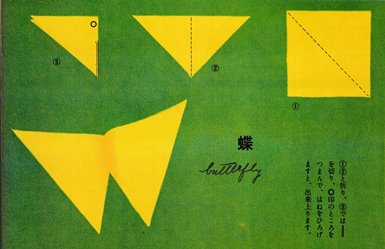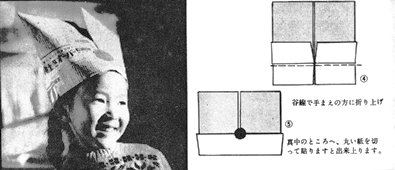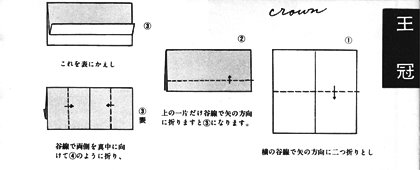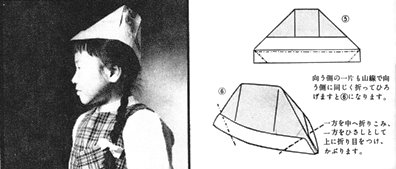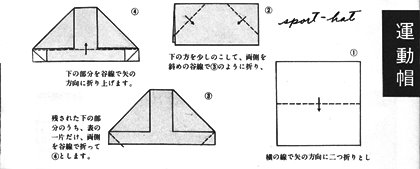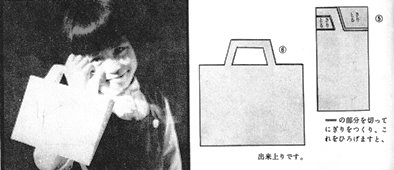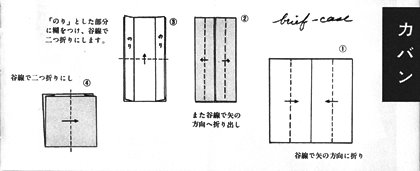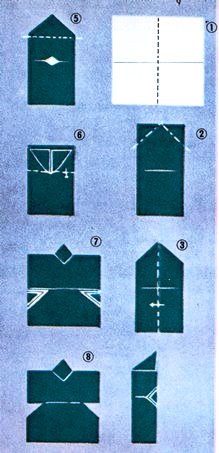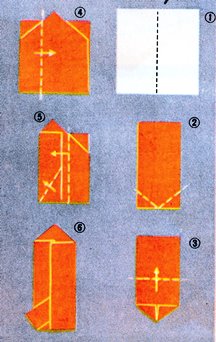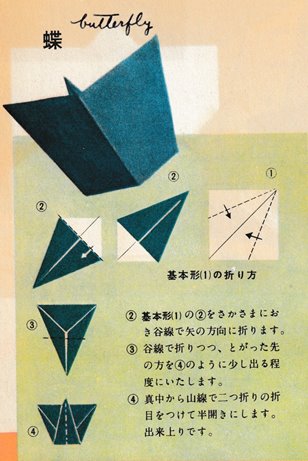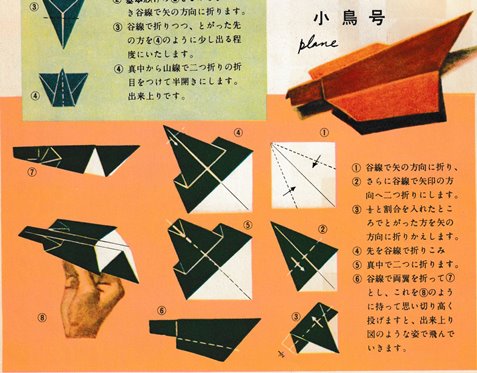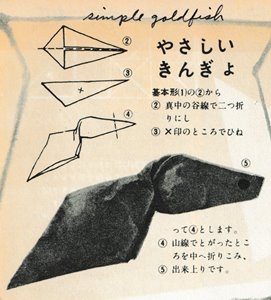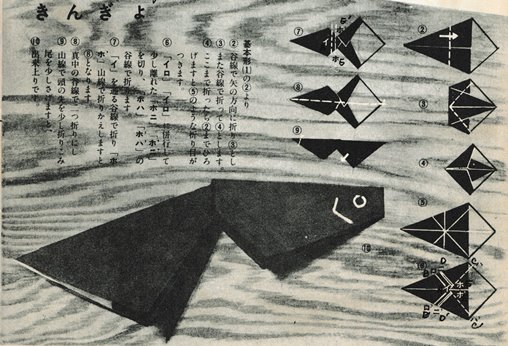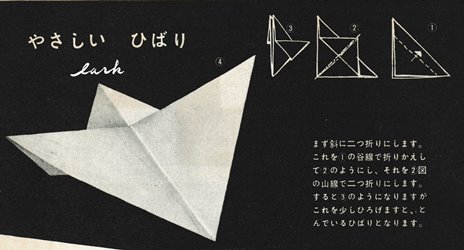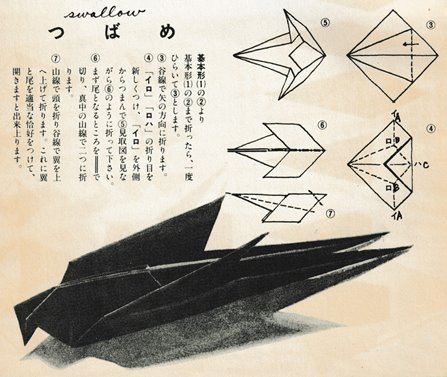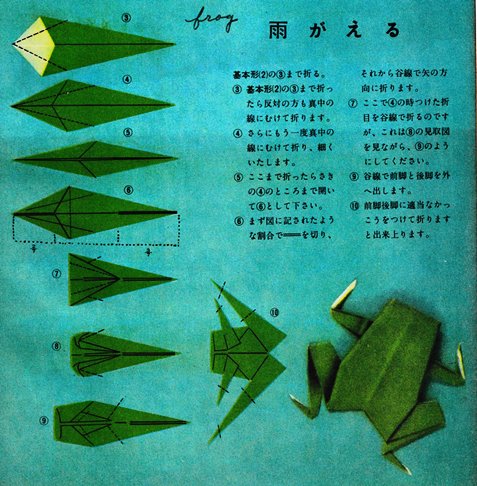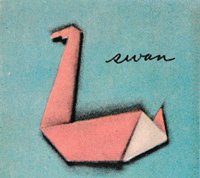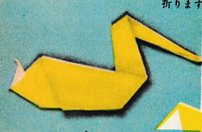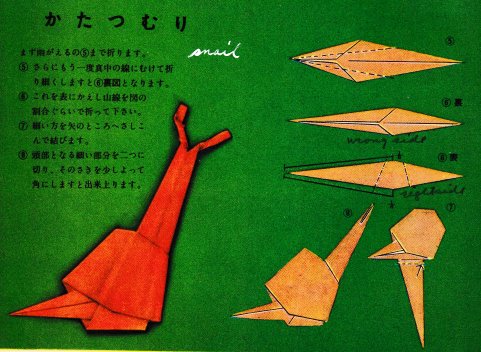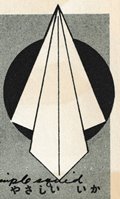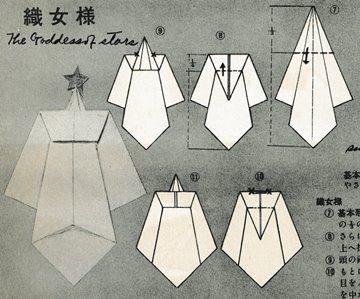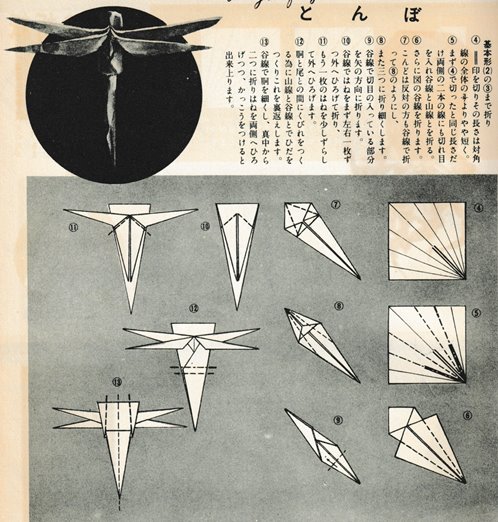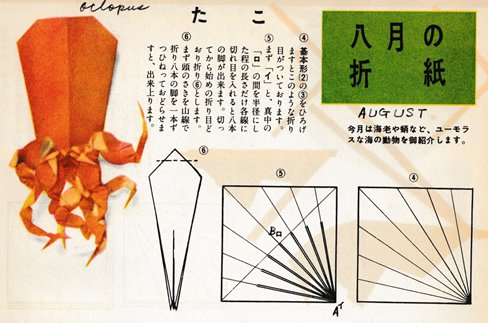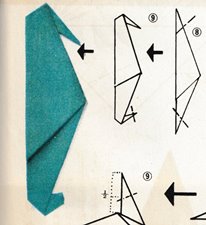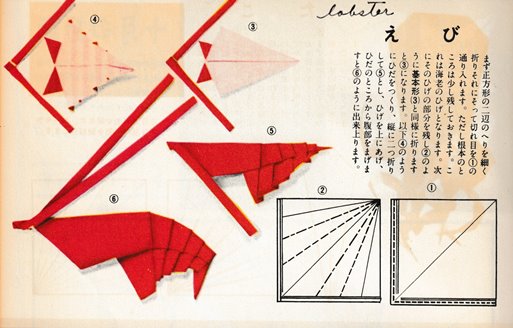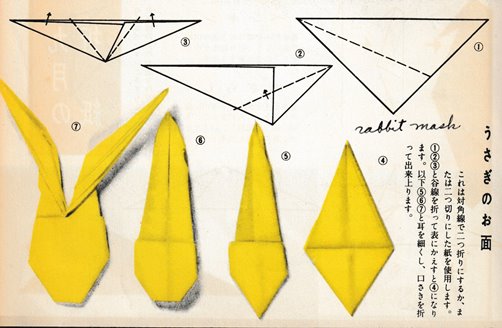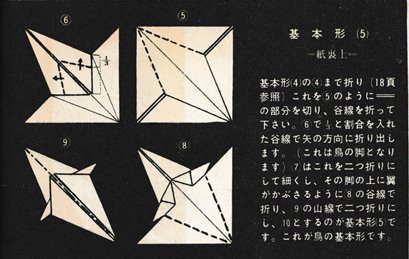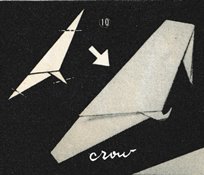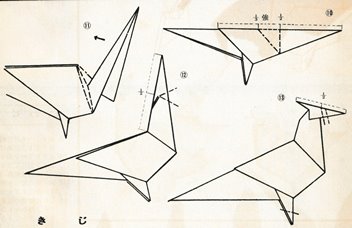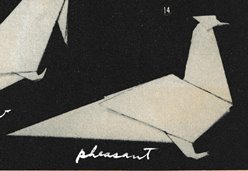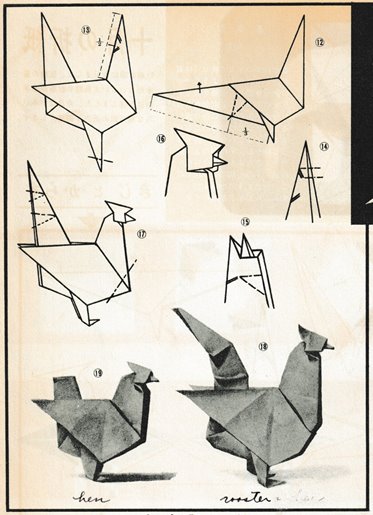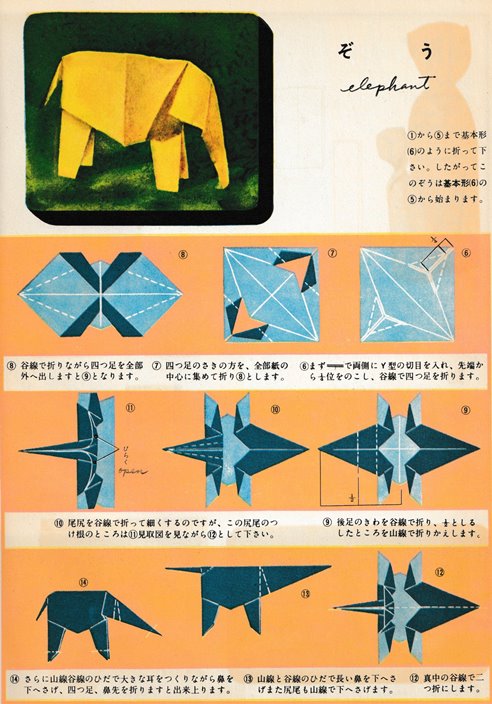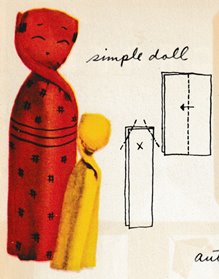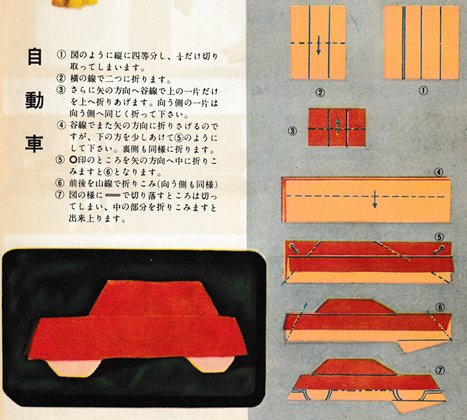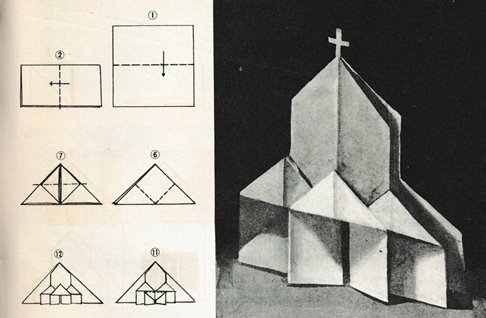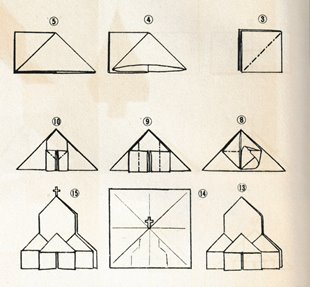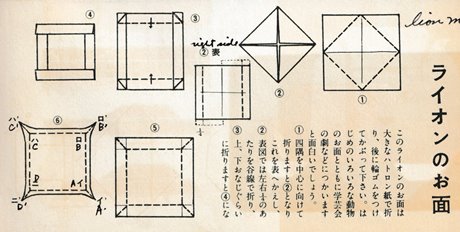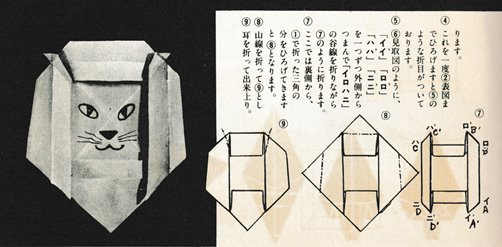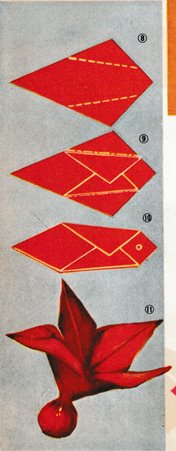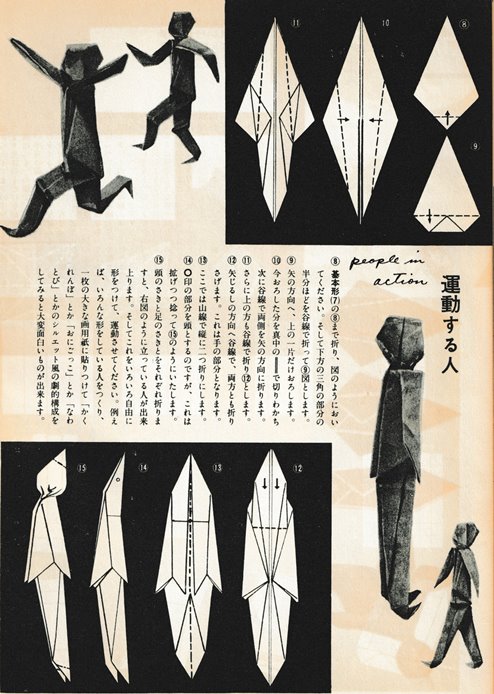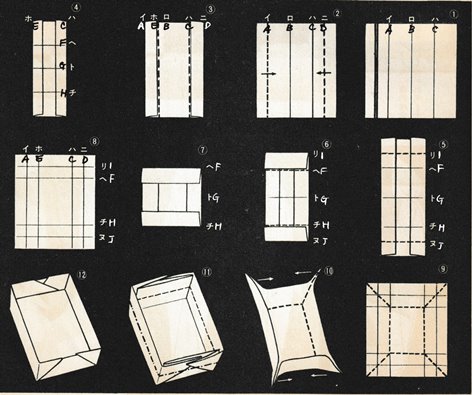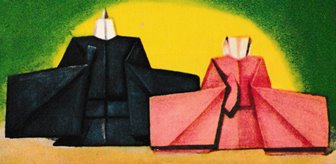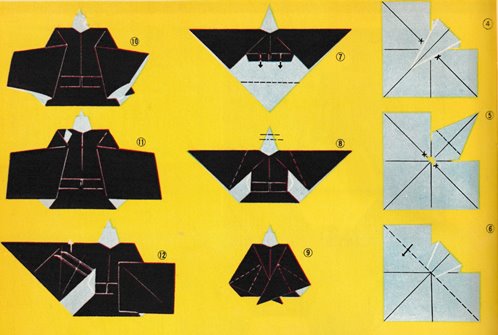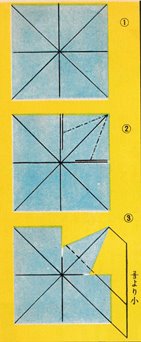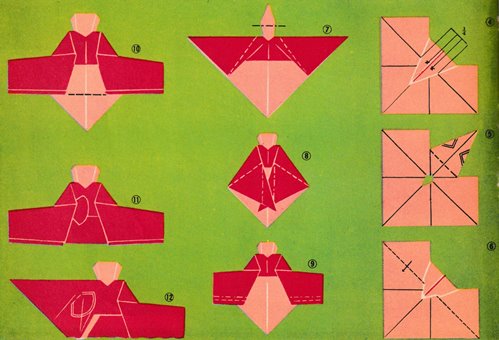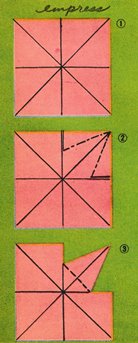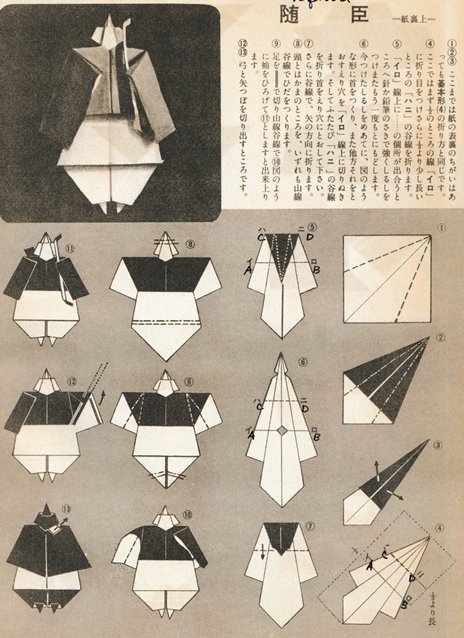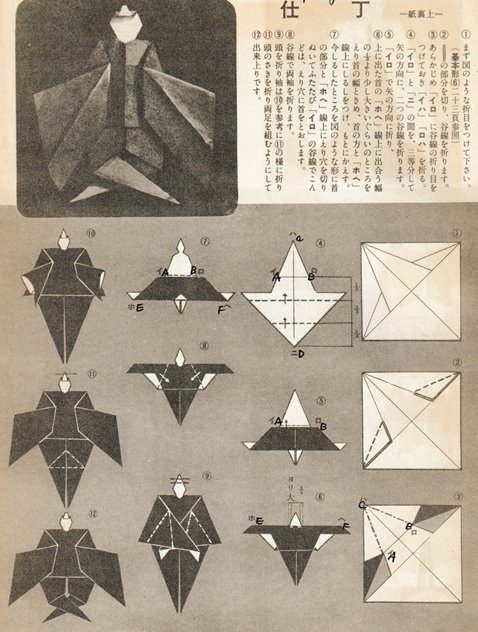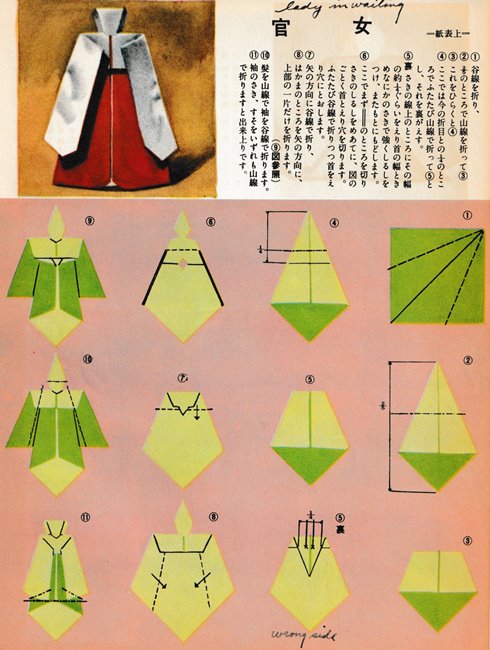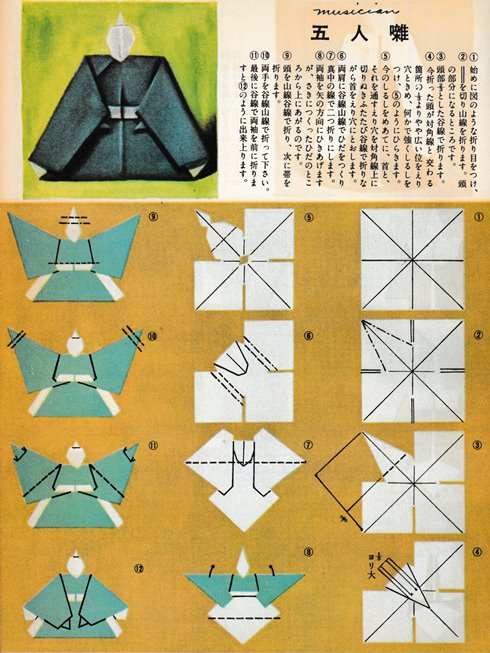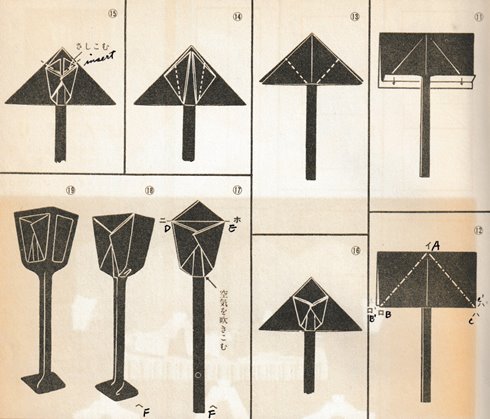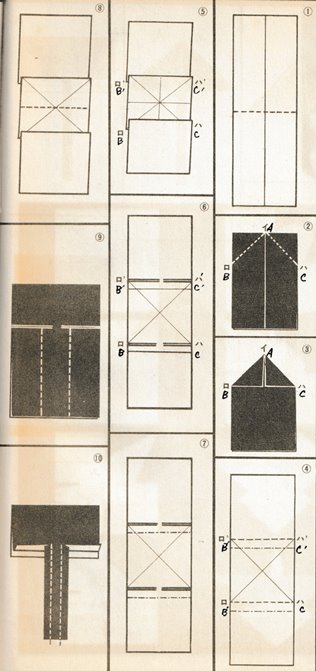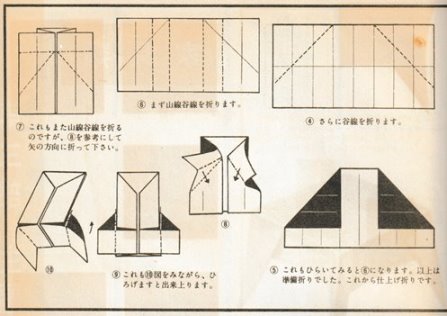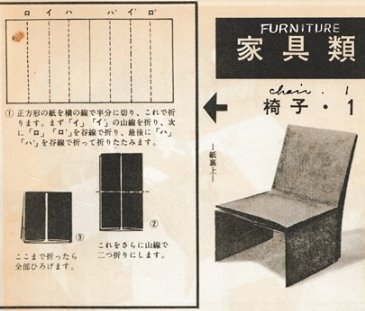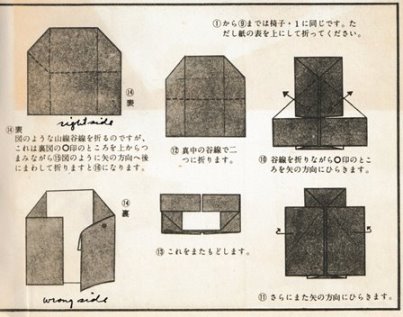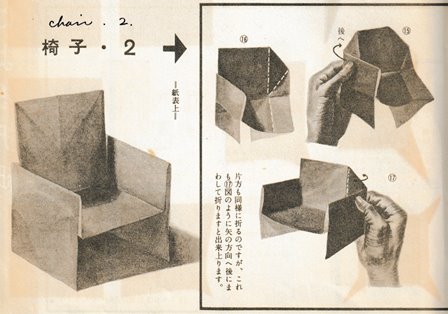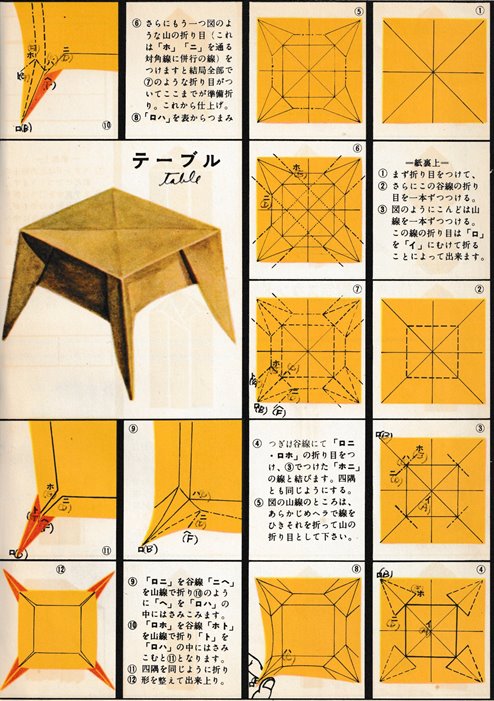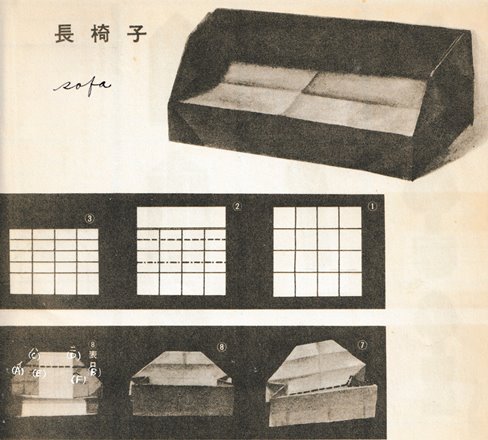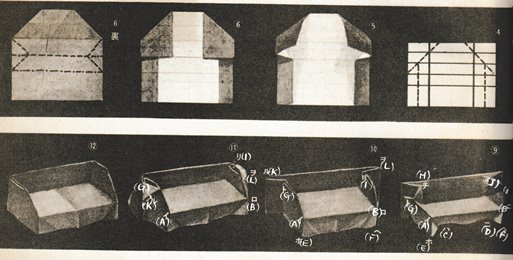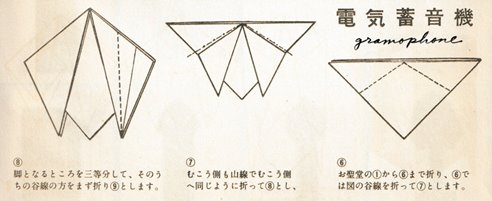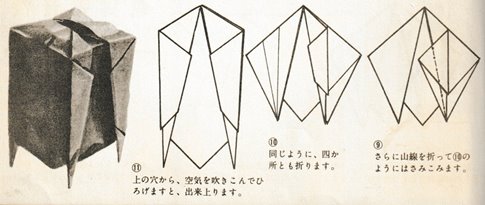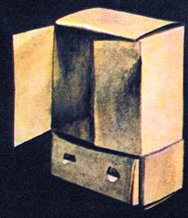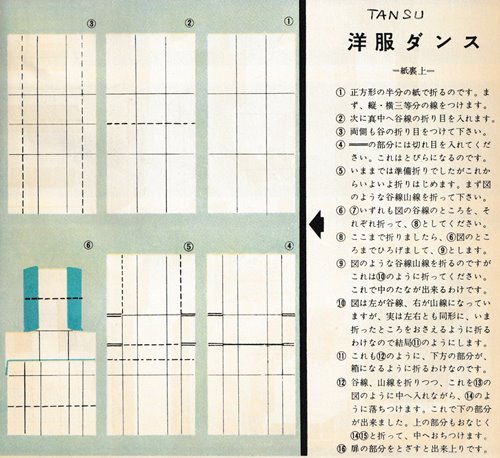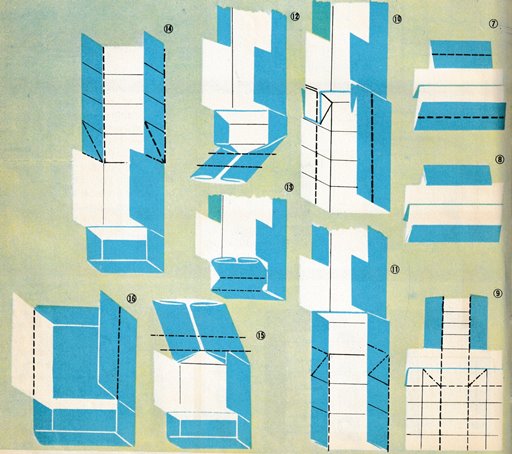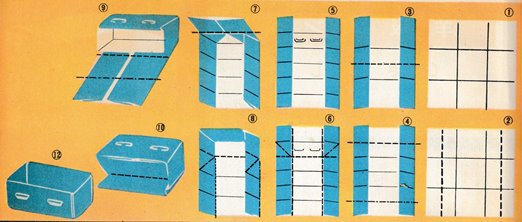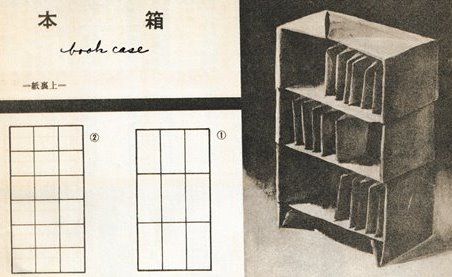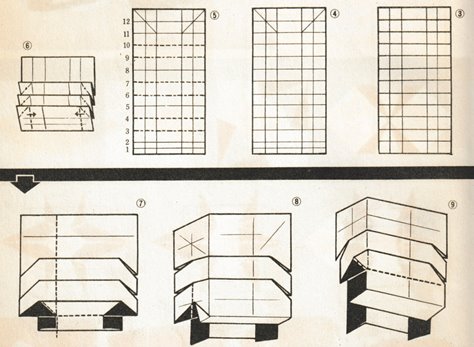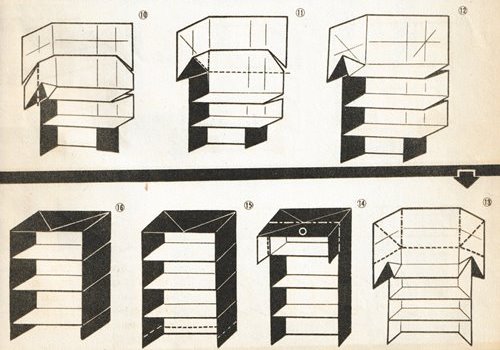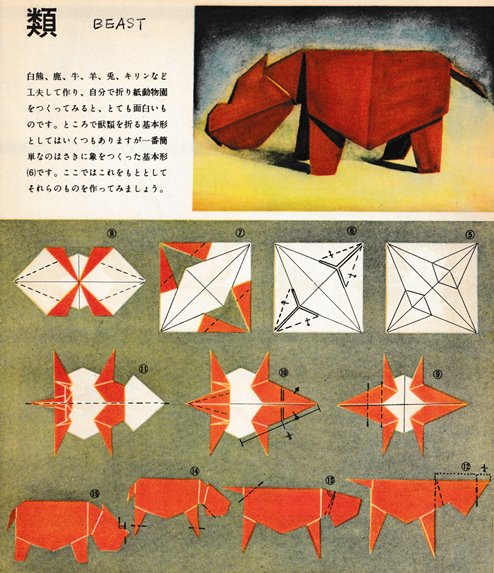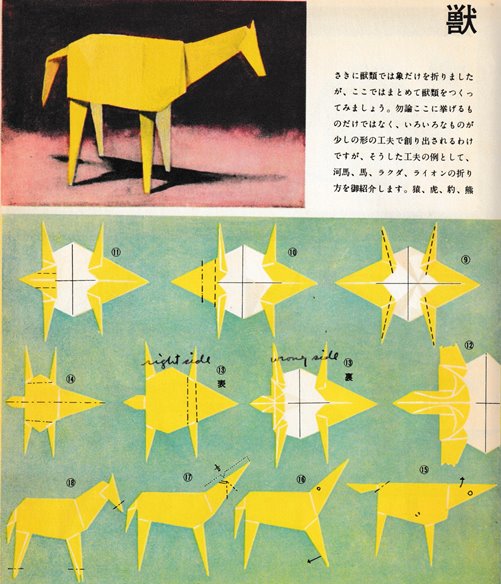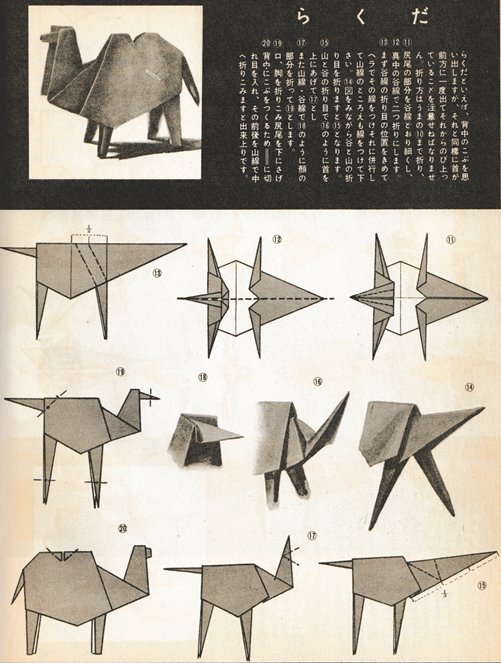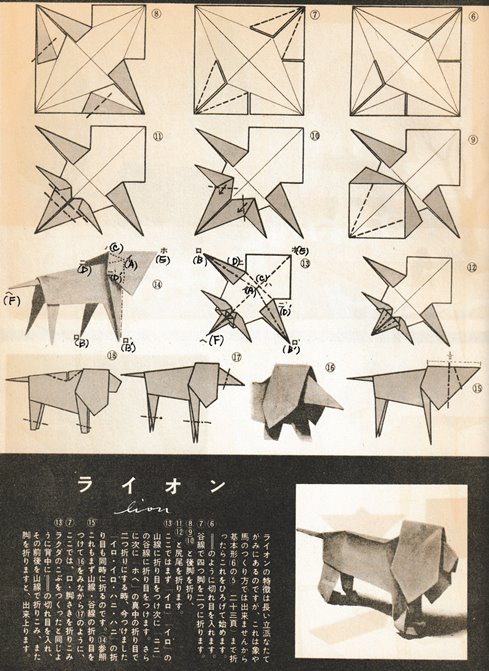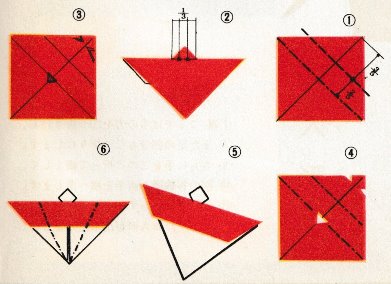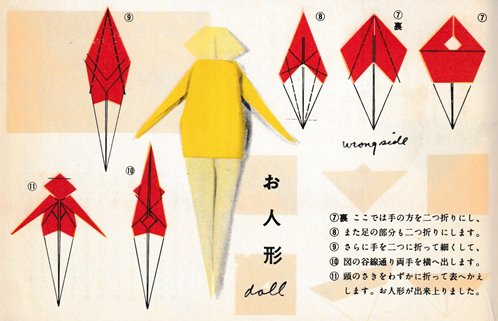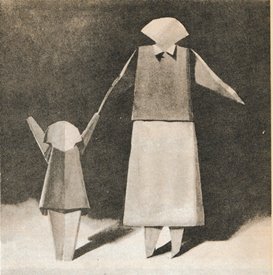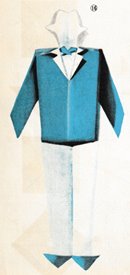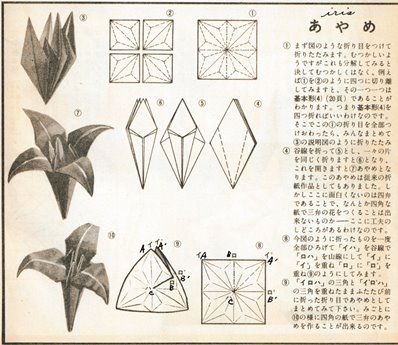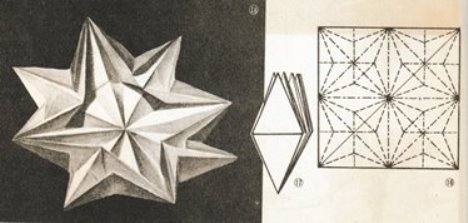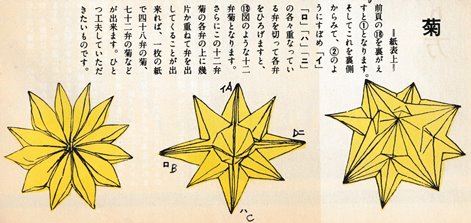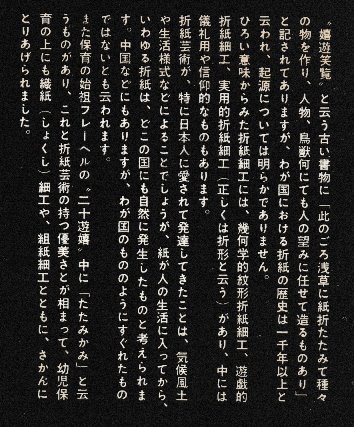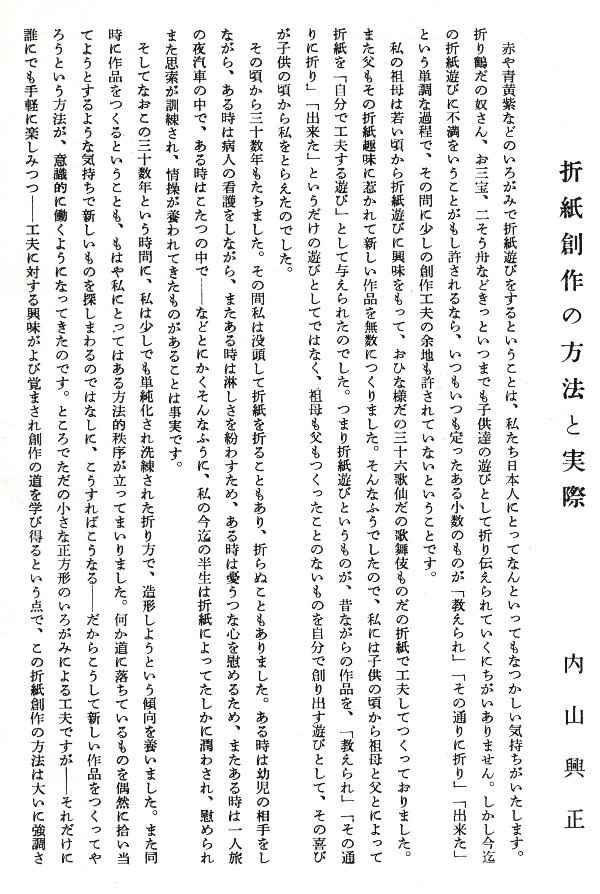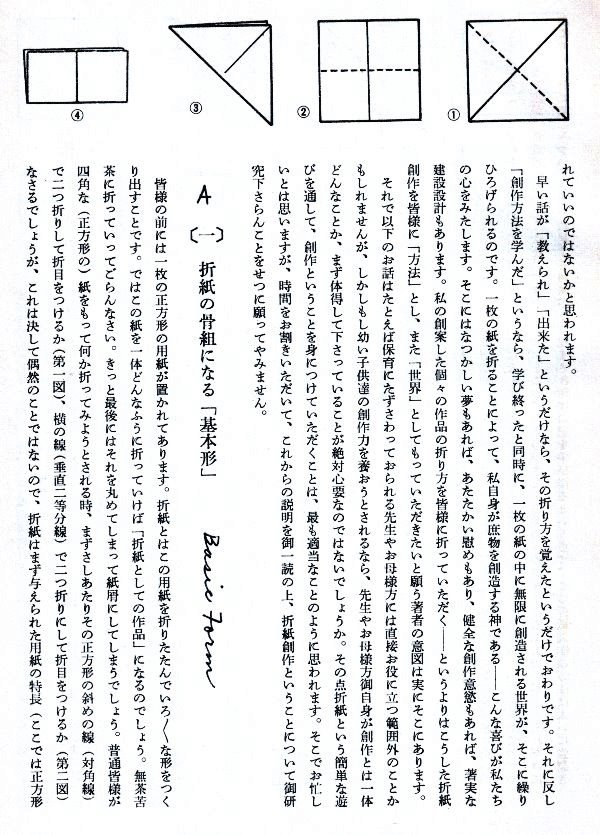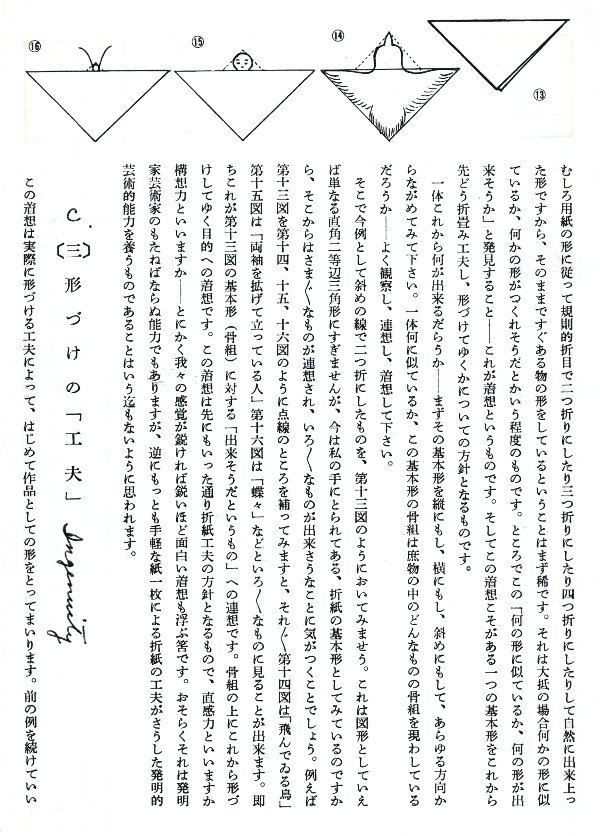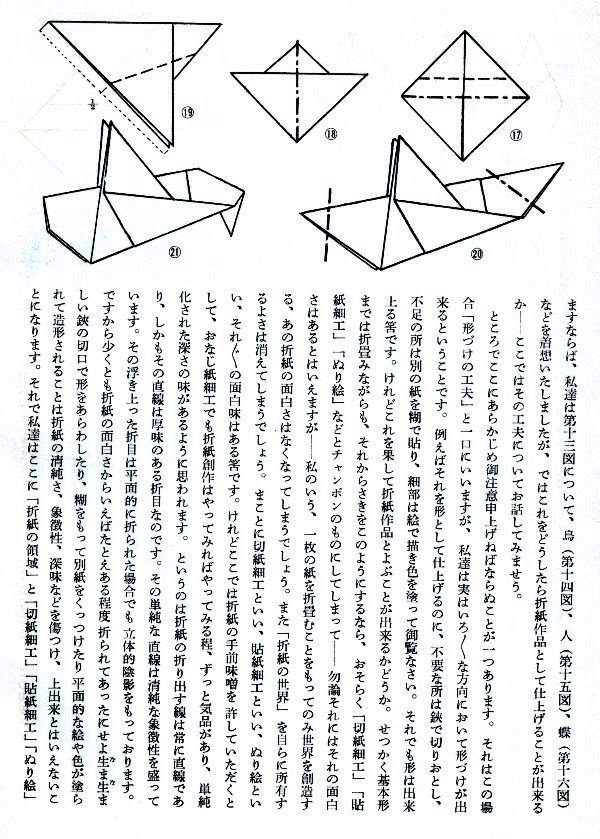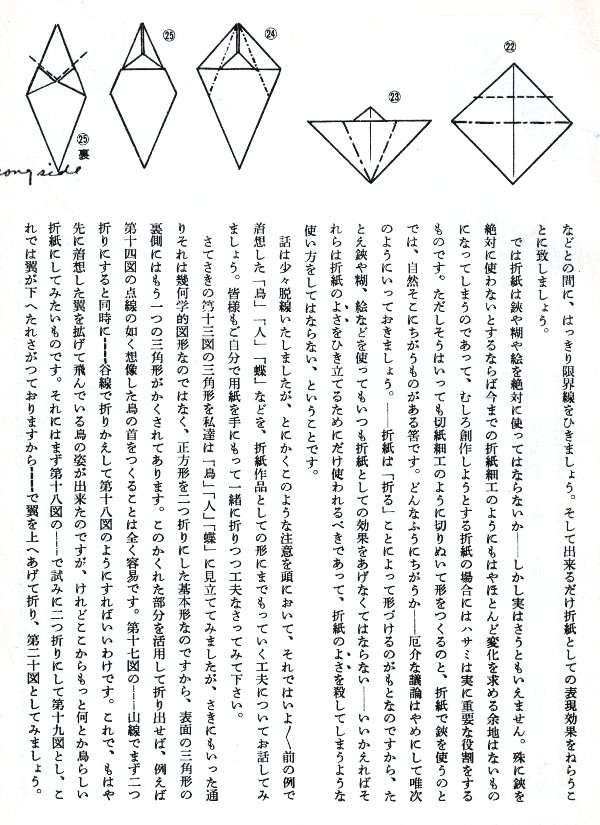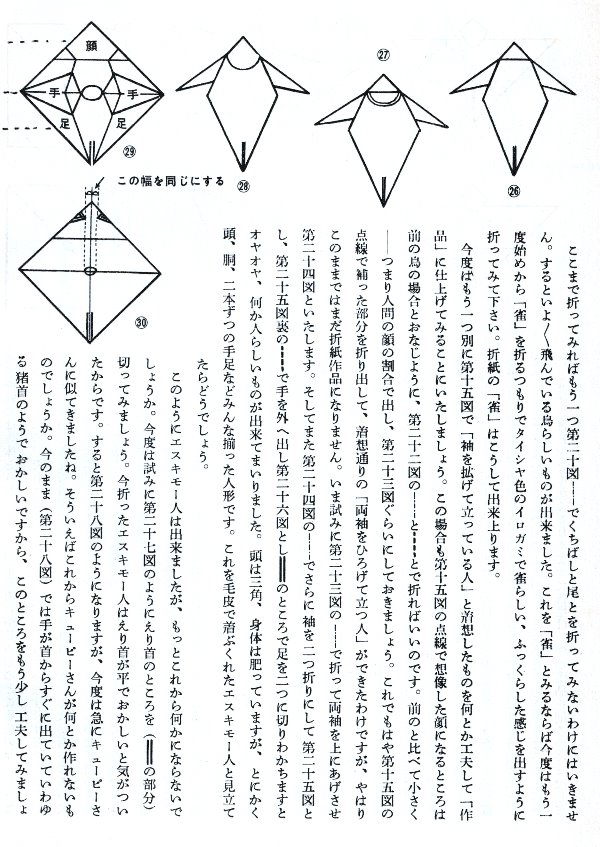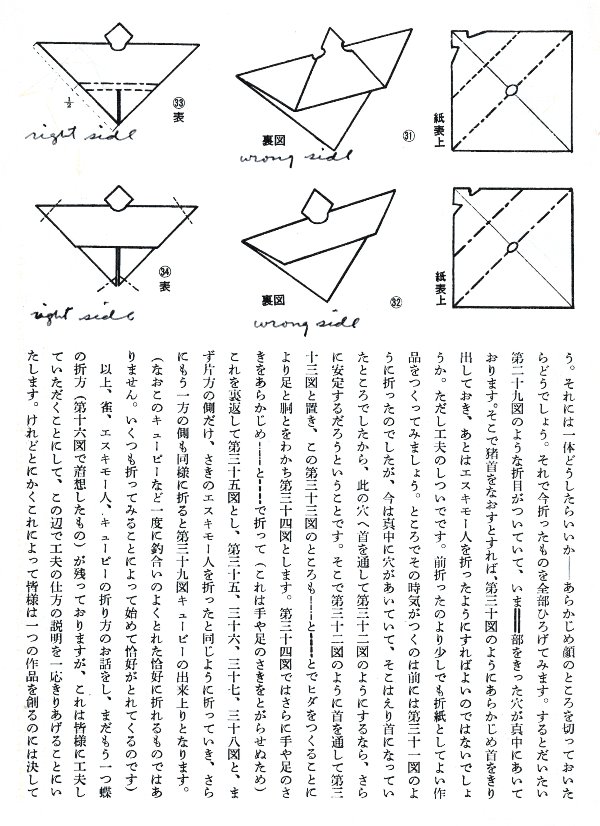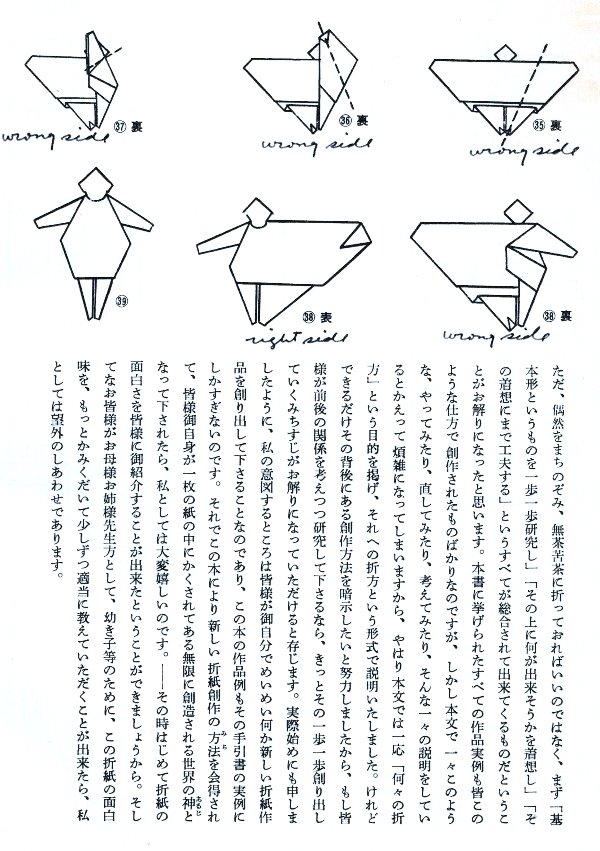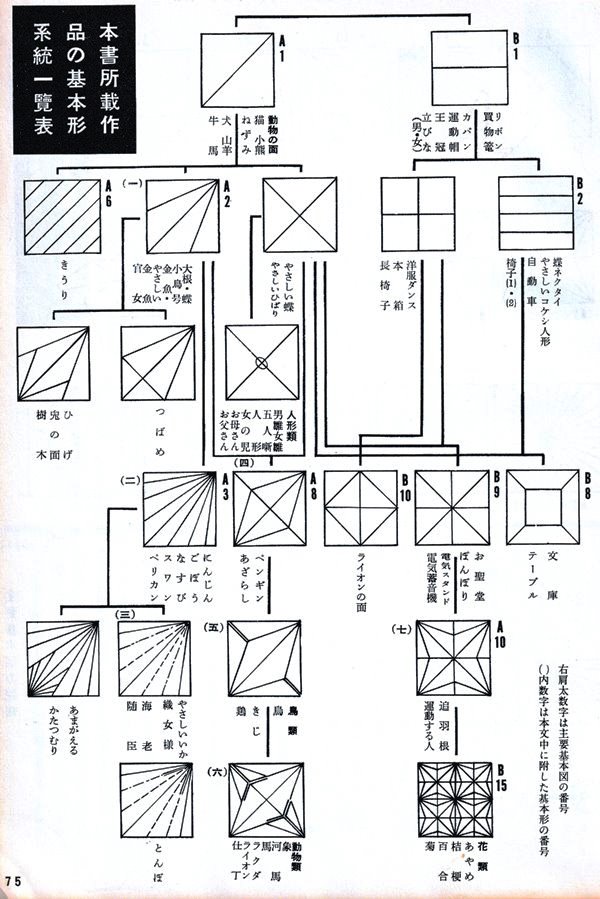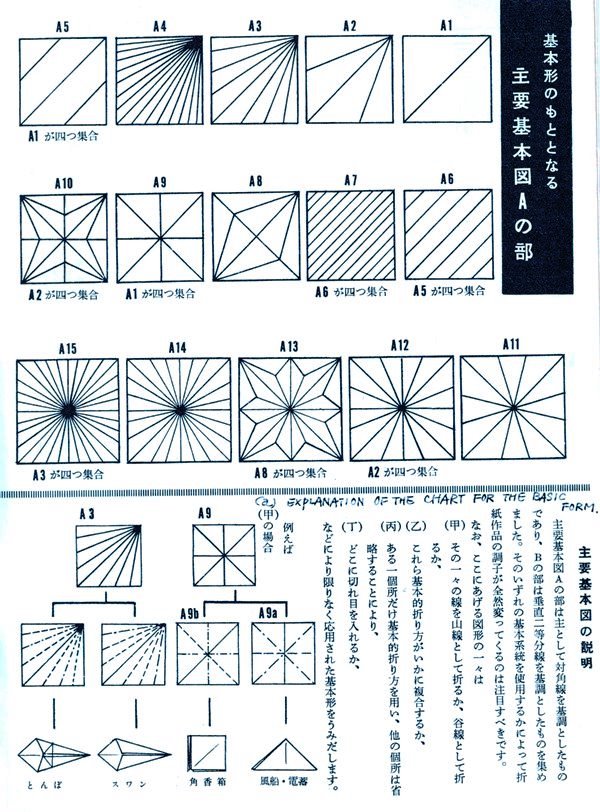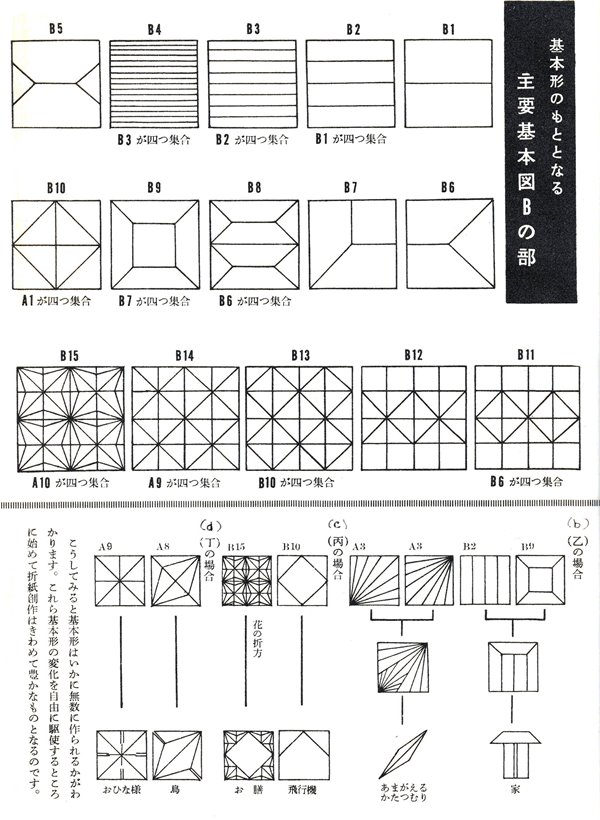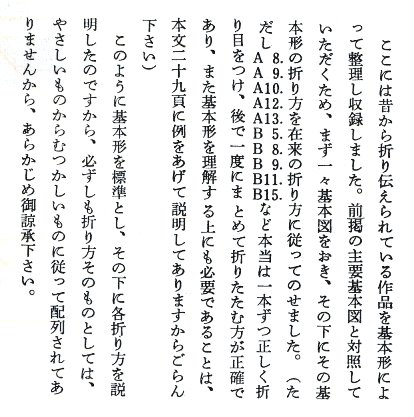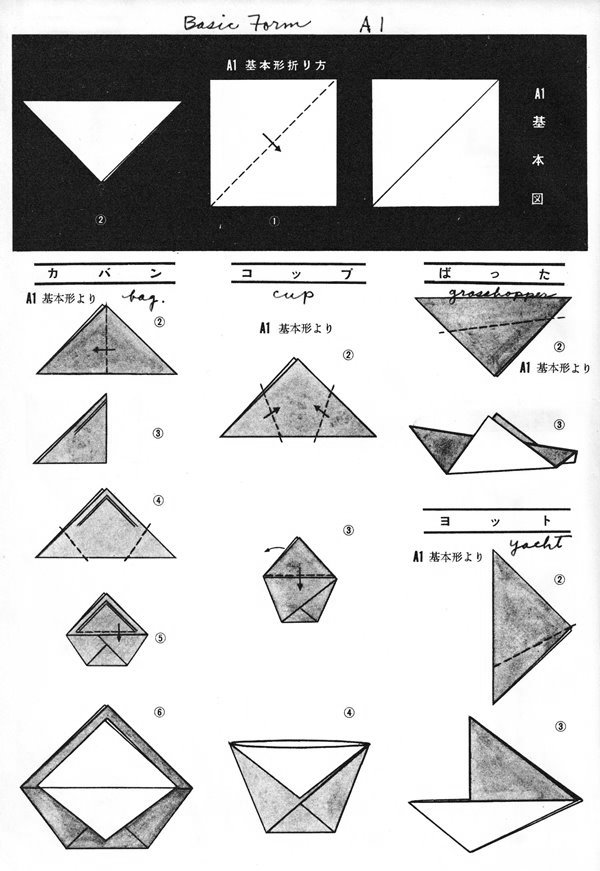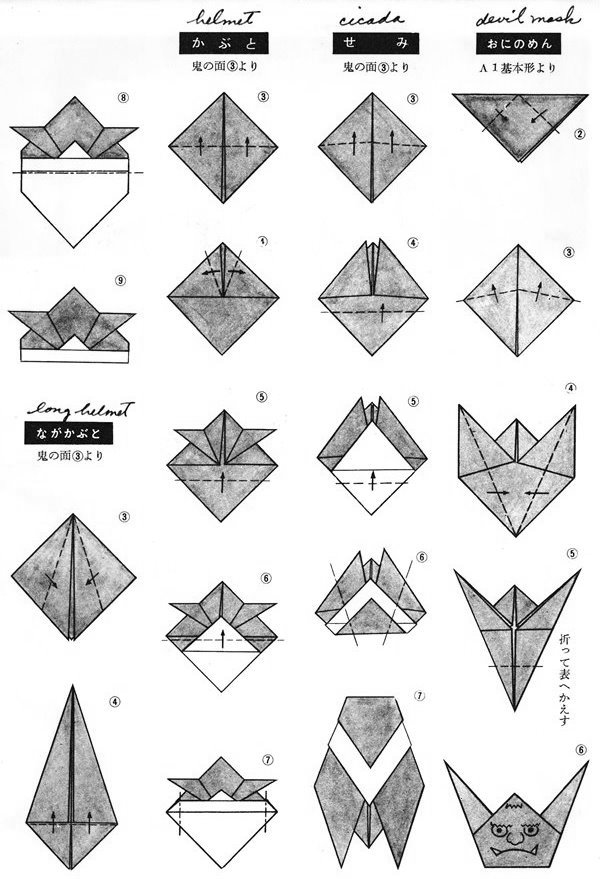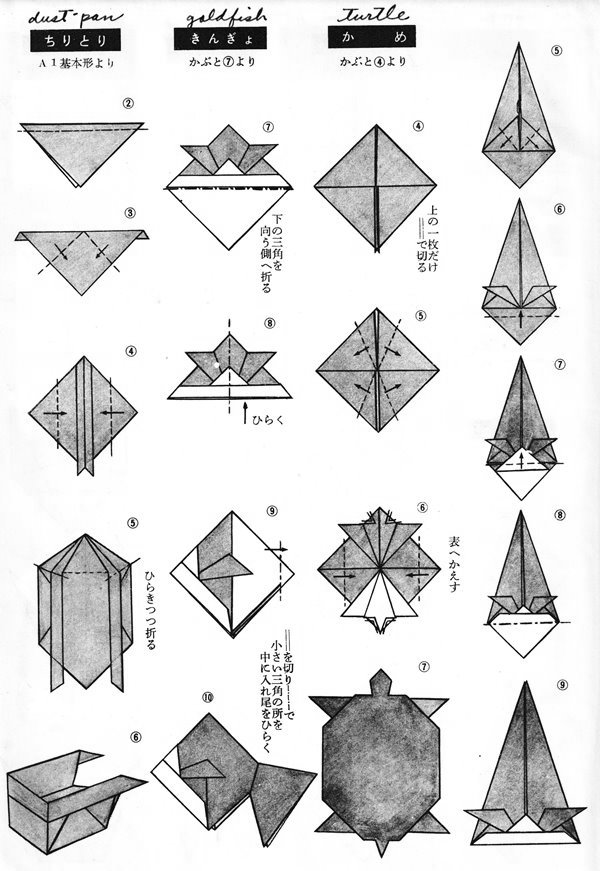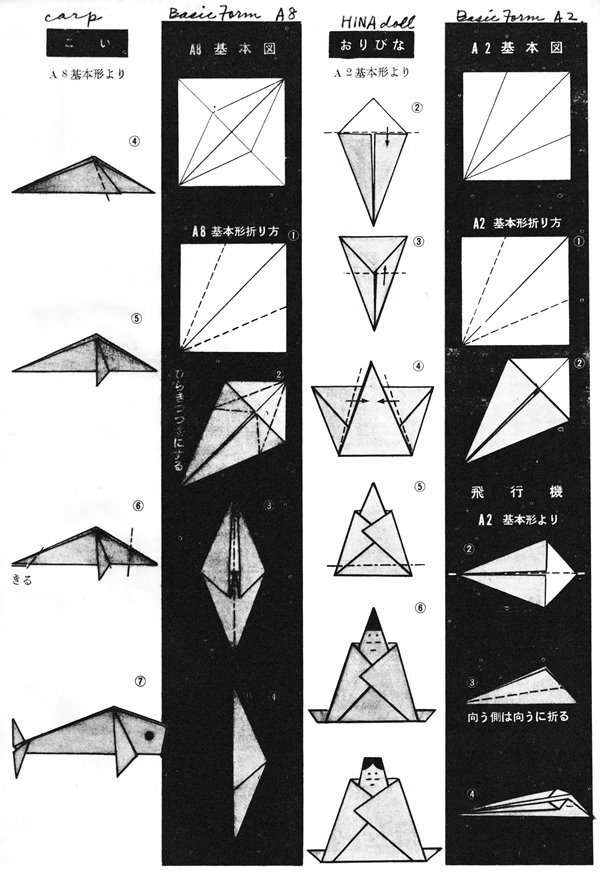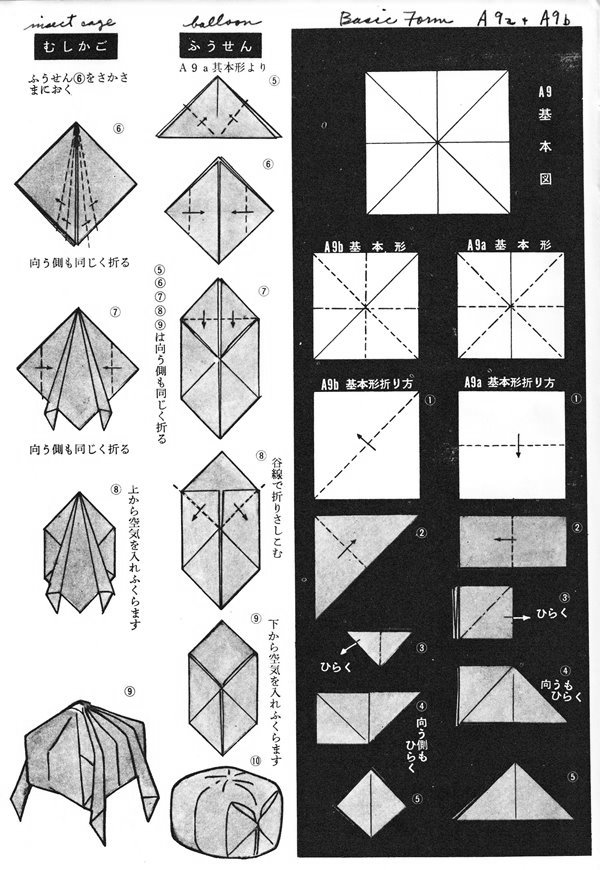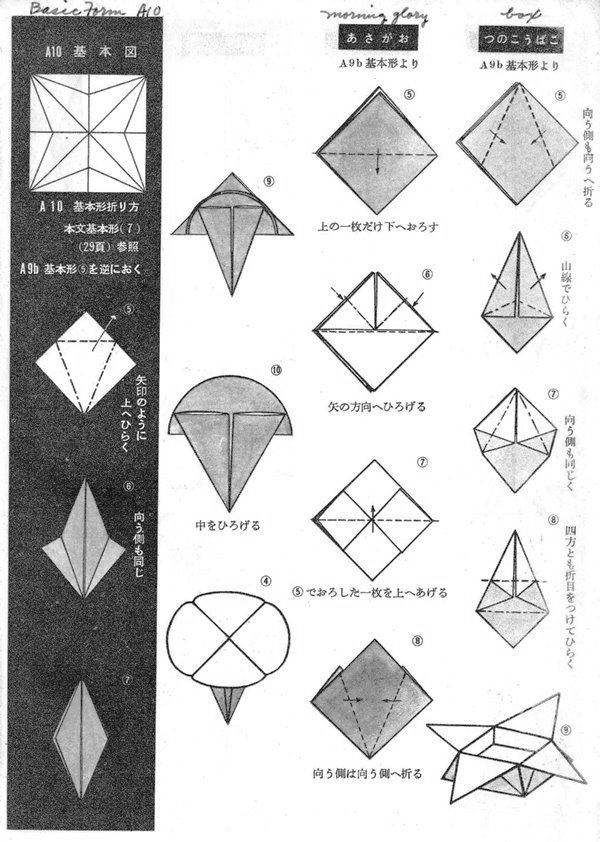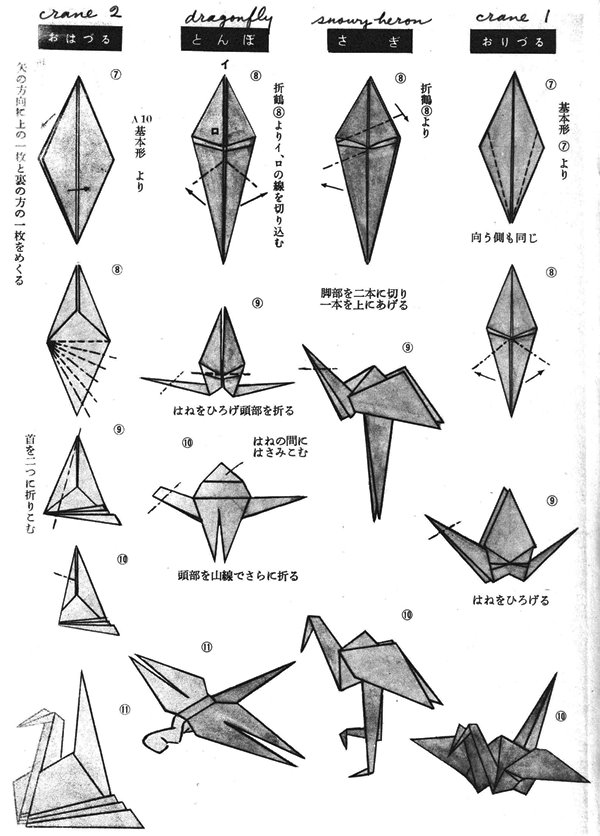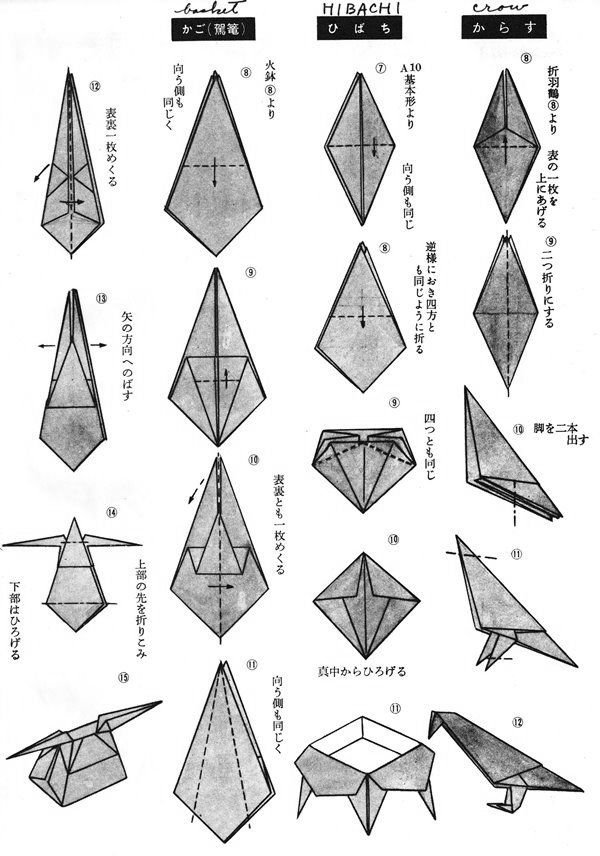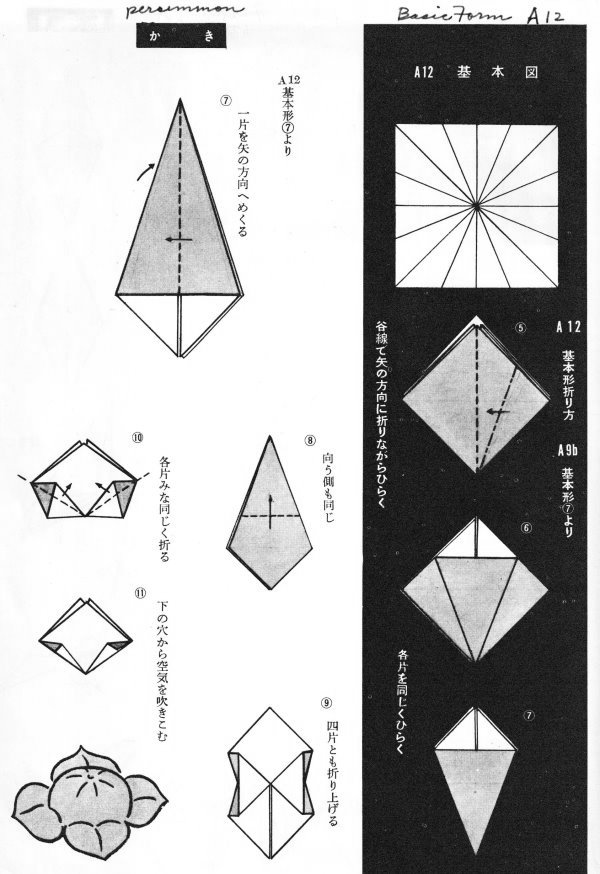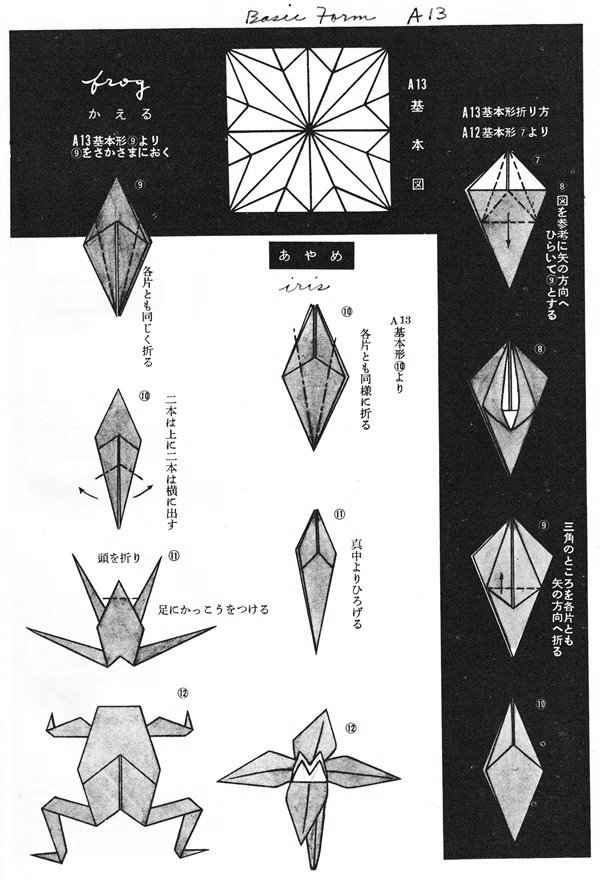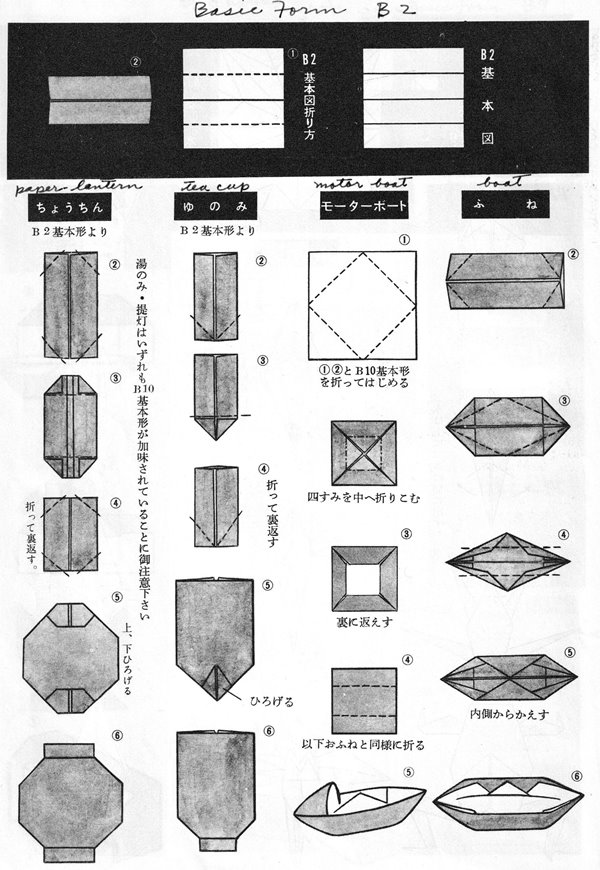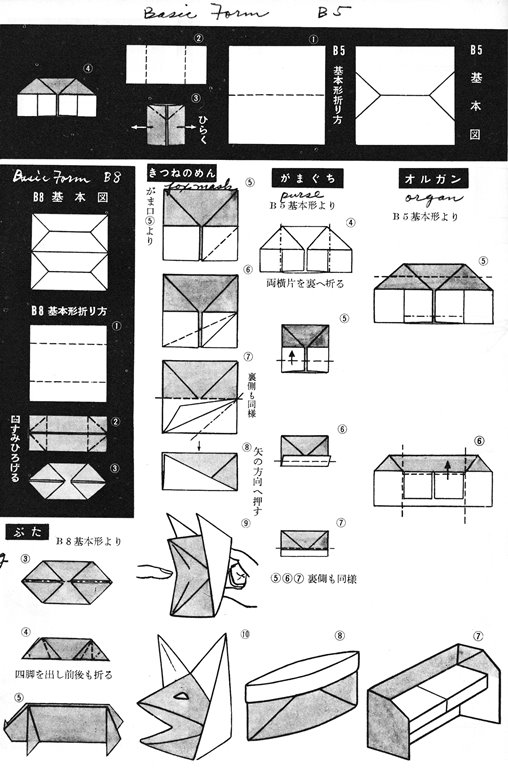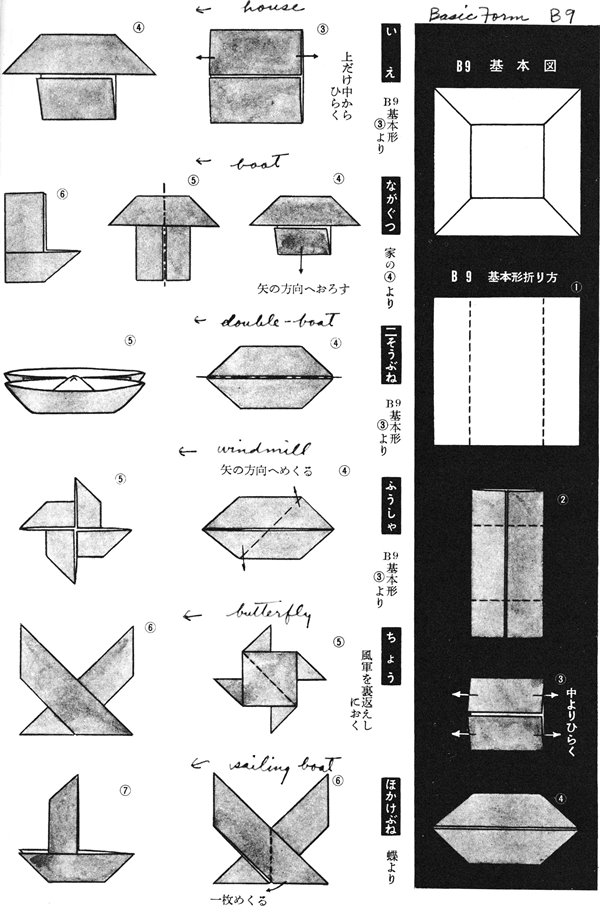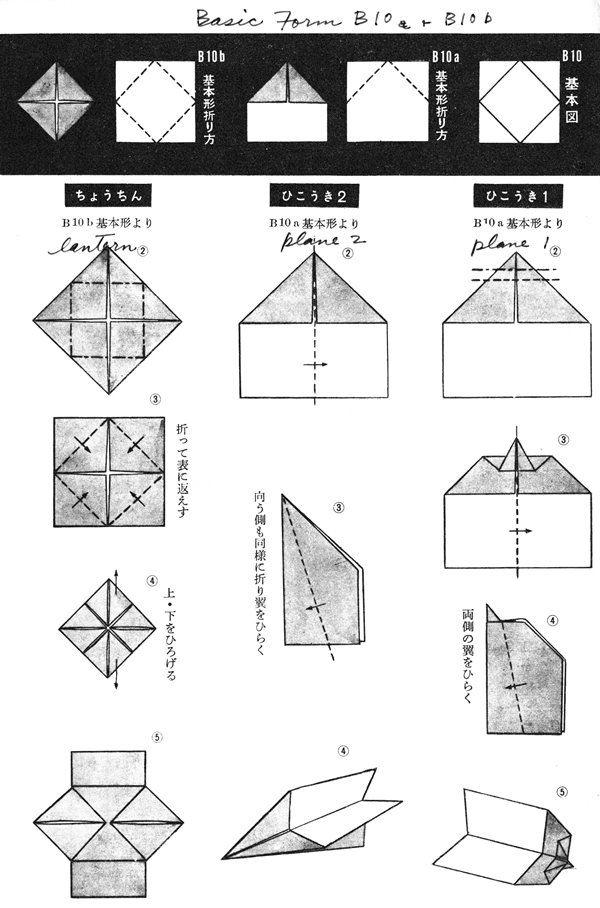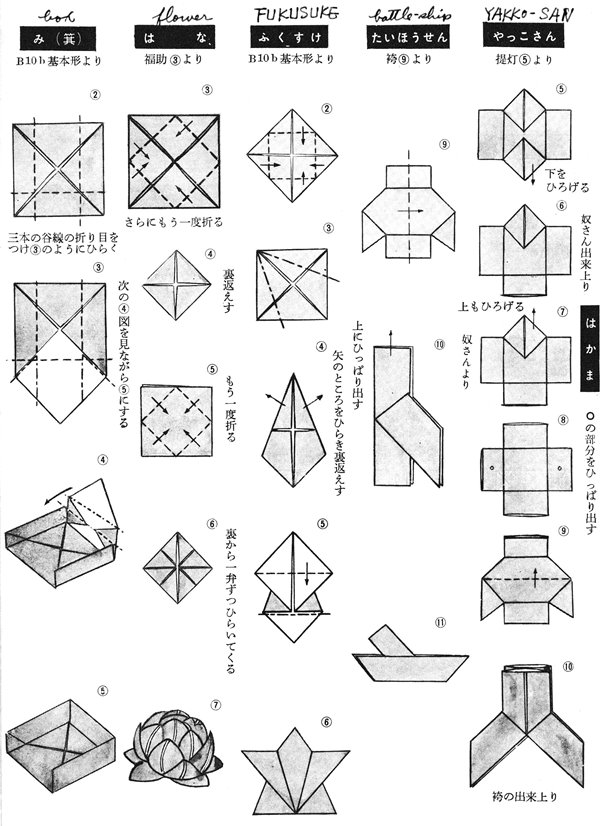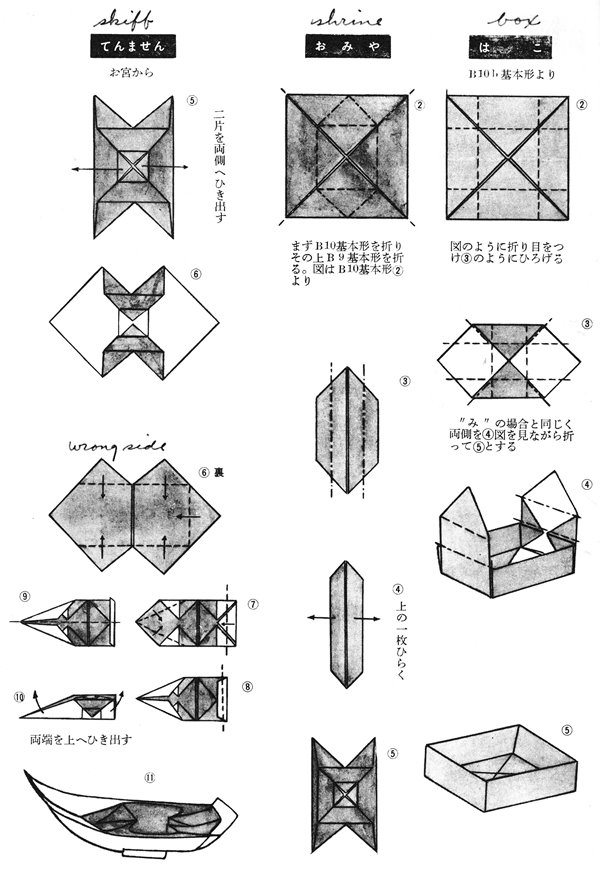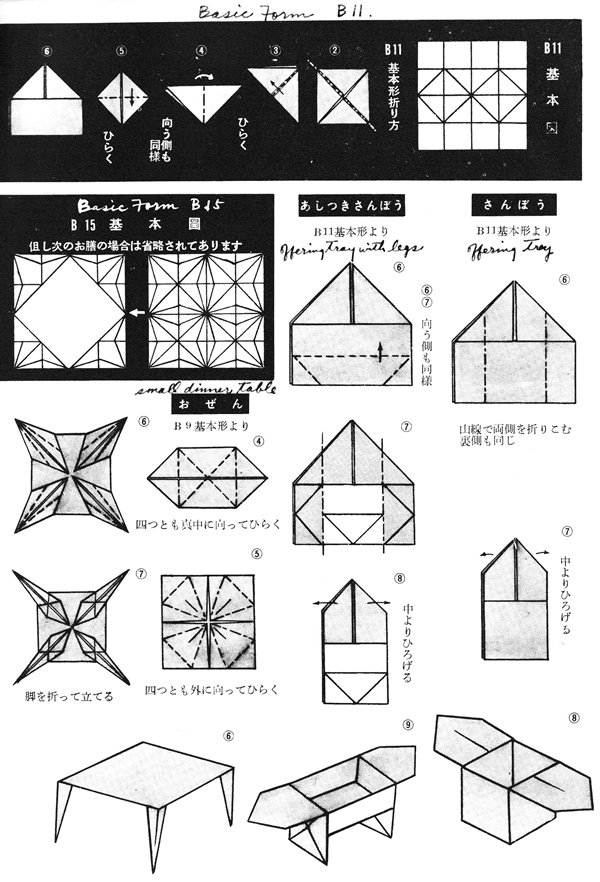| The Public Paperfolding History Project
Last updated 18/12/2024 x |
|||||||
| Yoku Wakaru Origami by Okimasa Uchiyama, 1956 | |||||||
| 'Yoku
Wakaru Origami' (Easy to Understand Origami) by Okimasa
Uchiyama was published by Hikari no Kuni Showa Publishing
in 1954. The information on this page is taken from a copy of the 1956 edition once owned by Eric Kenneway and which is now in the library of the British Origami Society. My grateful thanks to the Society for allowing me access to it. As far as I know the content of the 1956 edition is identical to that of the original. The handwritten translations are in Eric Kenneway's writing. Except in the case of the designs in the section dealing with 'Traditional Origami', the author does not say whether the designs are his own or those of some other known, or unknown, creator. Some of the designs may be his father's, or even his grandmother's work, but it is probably safe to assume that the majority of the designs are the author's own. The author does not distinguish between cut and uncut works and shows no awareness that many of the 'traditional' Japanese designs originated in Europe. **********
********** The author's introduction is titled 'For Teachers and Mothers' and the author makes it clear that his purpose in writing the book is to encourage adults and children not just to fold the existing traditional designs but also to create their own. To this end he sets out a system of crease patterns to be used as starting points and shows how these can be used as the basis of new and original works. He also demonstrates that these same crease patterns underly the 'ancient' traditional designs. Roughly translated, he says, inter alia: 'I ask all teachers, mothers and young children to take great care in preserving and guiding their creativity, and to go even further, to elementary, junior high and high school students, working fathers, adults and the elderly. I sincerely hope that through this modest book people from all walks of life will lend their support to make this uniquely Japanese game (ie origami) loved again after the new era.'
********** Analysis The work is divided into several sections and sub-sections: Part One - Origami for Beginners In this section, inter alia, the author introduces designs made with a simple twisting technique. In the section introduction he says, roughly translated: 'Since they have small hands, have them hold the paper with both hands and twist it as hard as they can'.
Ribbon
********** Necktie
********** Simple Basket (glued)
********** Moustache
********** Radish
********** Cucumber
********** Carrot
********** Egg Plant
********** Green vegetable
********** Burdock
********** Bear / Cat / Dog and Mouse Masks
********** Mountain Goat / Horse and Cow Masks
********** Butterfly (Cut)
********** Crown
********** Sports Hat - The Wide Hat
********** Briefcase (Cut)
********** Male (Cut) and Female Hina Dolls
********** Part Two - Origami Month by Month April Butterfly
********** 'Kojima' Paper Plane
********** May Easy Goldfish
********** Goldfish
********** Lark
********** Swallow (Cut) A cut is used to separate the two halves of the tail.
********** June It Rains (Cut) Cuts are used to separate the front and back legs.
********** Swan
********** Pelican
********** Snail (Cut) A cut is used to separate the horns.
********** July Simple Squid
********** Lady (Cut) A slit allows the neck to poke up through the shoulders. The head is a glued-on star.
********** Dragonfly (Cut) Cuts are used to create and separate the wings.
********** August Octopus (Cut) Cuts are used to create and separate the tentacles.
********** September Penguin From a fish base.
********** Seal From a fish base.
********** Shrimp (Cut) Cuts are used to create the feelers.
********** Rabbit Mask From a square or a right angle isosceles triangle.
********** October Crow Cuts are used to create the legs and the wings.
********** Pheasant Cuts are used to create the legs and the wings and the crest on the head.
********** Hen and Rooster Cuts are used to create the legs and the wings and the crests on the heads.
********** Elephant (Cut) The legs are created using cuts.
********** November Easy Kokeshi Doll
********** Car (Cut) The wheels are created using cuts. From a 3x4 rectangle.
********** December Cathedral (Cut) - The Church From a waterbomb base The cross is created using cuts.
********** Lion Mask
********** Tree
********** January Shuttlecock From a bird base The base is formed around a pebble or a small ball cut from an eraser.
********** People Exercising (Cut) From a bird base A cut is used to separate the legs.
********** February Bungu-bako (Stationery Box) From a 7 x 8 rectangle The sides are folded inwards to lock them together.
********** March Hina Dolls (Cut) Cuts are used to create the head and a slit allows the neck to poke up through the shoulders.
********** Followers (Cut) Cuts are used to shape the head, separate the legs and create the bow. A slit allows the neck to poke up through the shoulders.
********** Page (Cut) Cuts are used to create and shape the head and to separate the legs. A slit allows the neck to poke up through the shoulders.
********** Lady in Waiting (Cut) Cuts are used to shape the head. A slit allows the neck to poke up through the shoulders.
********** Musician Cuts are used to create ad shape the head and to separate the sleeves from the body. A slit allows the neck to poke up through the shoulders.
********** Lantern (Cut) Cuts are used to allow the central pillar to be thinner than the lantern or the base. The design is folded from a 3x1 rectangle. The top section is similar to a Waterbomb. The base has to be pasted onto cardboard to allow the design to stand.
********** Part Three - Themed Origami Furniture Chair No 1 Folded from a 2x1 rectangle
********** Chair No 2 Folded from a 2x1 rectangle
********** Table
********** Desk Lamp Folded from a 3x4 rectangle.
********** Chaise Longue Folded from a 3x4 rectangle.
********** Electric Gramophone
********** Wardrobe (Cut) Cuts are used to create the doors.
********** Drawer to fit into Wardrobe
********** Bookcase Folded from a 2x1 rectangle
********** Books for Bookcase
********** Animals Hippopotamus (Cut) Cuts are used to create the legs, release extra paper to broaden the face and create the ears.
********** Horse (Cut) Cuts are used to create the legs and the ears.
********** Camel (Cut) Cuts are used to create the legs and to separate the humps.
********** Lion (Cut) Cuts are used to create the legs (which also releases the extra paper required for the mane) and to shape the back.
********** Human Figures All these figures are variations developed from the same cut base. Doll (Cut) Cuts are used to separate the legs and shape the head. A slit allows the neck to poke up through the shoulders..
*********** Mother, Father and Daughter (all cut) These three figures are made in a very similar way.
********** Flowers Iris - The Lily Three and four-petalled versions are explained. Unusually, the three-petalled version is made from a square and is uncut.
********** Chrysanthemum This design is made from a quadrupal bird base crease pattern using cuts. The instructions are not completely clear as to how this is to be achieved.
********** Supplement - Creative Origami and its Practice
The Preface to this section roughly translates as: 'In an old book called 'Yuusha' it says, 'These days I sometimes fold paper. It is written that 'origami' can be used to create objects, people, or anything else that a person desires', but the history of origami in japan is said to be over 1000 years old, and its origina are unclear. In the broad sense of the word, origami crafts include geometric origami crafts, recreational origami crafts, and practical origami crafts (properly called origata). Some are for ceremonial or religious purposes. The fact that origami art has been loved and developed by Japanese people in particular may be due to the climate, culture and lifestyle, but it is thought that origami naturally emerged in everyt country after paper was introduced into people's lives. It exists in China and other countries, but there is no origami as excellent as that in Japan.' I have not managed to identify the 'old book called 'Yuusha''. In the following pages the author first gives an overview of his family's engagement with origami and how he learned to be a 'creative' paperfolder, and then gives examples of how new designs can be developed from basic forms, using folding, cutting and decoration. The first paragraphs of the first page of the main terxt of this section (reproduced in full below) roughly translate as: 'For we Japanese, playing with red, blue or purple origami paper evokes a nostalgic feeling. I'm sure that paper cranes, yakkosan, sanbo and nisobune will continue to be passed down as children's games for a long time. However, if it is permissible to complain about the origami of the past, it is that we are always being taught 'folding exactly as instructed' and 'finished' in a monotonous process that leaves no room for creativity or ingenuity. My grandmother was interested in origami from a young age, and would use it to create Hina dolls, the Thirty-Six Poets, and Kabuki pieces. My father was also obsessed with origami and created countless new designs. Because of this origami was presented to me by my grandmother and father, from a young age, as a 'game of ingenuity'. In other words, origami was not just a game of being taught how to make traditional pieces, 'folding them exactly as instructed' and 'finished', but a game of creating something by myself that neither my grandmother nor my father had ever made, and the joy of this captured me from an early age. Thirty-odd years have passed since then. During that time there were times when I was absorbed in folding origami, and times when I wasn't. Sometimes while looking after my small children, sometimes while nursing the sick, sometimes to allay my loneliness, sometimes to sooth my gloomy heart, sometimes while travelling alone on a nnight train, sometimes while sitting under a kotatsu ... in all these ways it is true that origami has enriched and comforted the last half of my life, refined my thoughts and comforted my emotions.' On the 4th page there is an interesting discussion of origami ethics. Roughly, and poorly, translated it reads: 'By the way, there is one thing I mustr warn you about in advance. Altghough we talk of 'devising ways to shape it' in reality private roads can be devised in a number of different directions. For example, to finish the design try cutting off the unnecessary parts with scissors, pasting in the missing parts with different paper, or drawing and painting in the details. If you do this, you should be able to complete the design. But can this really be called an origami work? Even if you create the basic shape by folding, if you continue in this way from there, it will probably be called 'paper cuttung' or 'pasting'. If we were to mix it up with 'paper crafts' and 'colouring books' ... Of coursew, there is an appeal to that, but the appeal of origami, which I'm talking about, of creating a world only by folding a single piece of paper, would disappear.' This sentiment 'of creating a world only by folding a single piece of paper' is strangely at odds with the content of the work.
********** Supplement - Charts of the Basic Forms used in the work Note that this chart contains both uncut and cut basic forms (crease patterns).
********** Supplement - Traditional Origami
The Preface to this section roughly translates as: 'Here we have collected works that have been handed down since ancient times, organised by basic shape. In order to allow you to compare them with the main basic diagrams given above (ie in previous sections) we have provided each basic diagram and then provided the folding method for that basic shape according to the traditional folding method underneath it. (However for shapes such as A8, A9, A10, A12, A13, B5, B8, B9, B11 and B15, it is actually more accurate to make the correct creases one by one and then fold them all together later, and this is also necessary for understanding the basic shapes (please see the the examples on p29 for an explanation).' Bag - Cup - The Paper Cup Grasshopper - Yacht - The Yacht
********** Helmet - The Kabuto Cicada - The Kabuto-base Cicada Devil Mask - The Devil Mask
********** The Long Helmet - The Nagakabuto Dustpan - The Dustpan Goldfish - The Cut Goldfish Turtle - The Cut Turtle
********** Carp - Hina Dolls - Plane - The Paper Dart (folded from a square)
********** Insect Cage - The Mushikago Balloon - The Waterbomb
********** Morning Glory - The Morning Glory Box - The Star-Shaped Box
********** Crane 1 - The Paper Crane Snowy Heron - Dragonfly - The Cut Dragonfly Crane 2 - The Nesting Crane
********** Crow - The Standing Crow Hibachi - The Hibachi Palanquin - The Kago
********** Persimmon - The Persimmon
********* Frog - The Inflatable frog (although this version of the Inflatable Frog does not seem to be intended to be inflated) Iris - The Lily
********** Boat - Inside-Out Boat Motor Boat - The Sampan Tea Cup - The Urn Paper Lantern - The Long Lantern
********** Organ - The Piano Purse - The Wallet / Nurse's Cap Fox Mask - The Fox Mask Pig - The Pig (Note that the House is only shown as a basic form rather than as a design in its own right.)
********** House - The Japanese House Boat - Double Boat - The Double Boat Windmill - The Windmill Butterfly - The Vase Sailing Boat - The Boat with Sail
********** Plane 1 - Plane 2 - The Paper Dart (folded from a square) Lantern - The Lantern
********** Yakko-san - Yakkosan Hakama - The Trousers Taihousen - The Battleship Fukusuke - Simple Fukusuke Flower - The Waterlily (the illustration shows a double version of this design) Winnowing Box - The Winnowing Box (Note that the Cross and the Jacket are only shown as intermediate forms rather than designs in their own right.)
********** Box - The Blintz Box Omiya (Shrine) - The Tenjin Shrine Tenmasen - The Takarabune
********** Sanbo - The Sanbo Ashitsuki Sanbo - The Sanbo on Legs Ozen - The Chessboard
********** |
|||||||


